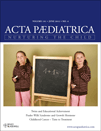Simultaneous presence of human herpesvirus 6 and adenovirus infections in intestinal intussusception of young children
Abstract
Aim: This prospective study investigated the role of viral infections in the pathogenesis of intussusception, including human herpesvirus 6 (HHV-6), a known lymphotropic virus.
Methods: Fifty-three children with intussusception treated in hospital were enroled, and children of comparable age and gender served as controls. Blood, stool and throat swab specimens, as well as mesenteric lymph nodes and pieces of intestine from patients requiring surgery were tested for various viruses by PCR methods.
Results: Altogether, 85% of intussusception cases showed evidence of a recent or ongoing viral infection. Among the 53 intussusception cases, adenovirus was detected in 25 (47%), HHV-6 in 24 (45%), rhinovirus in 12 (23%), cytomegalovirus in 7 (13%), enterovirus in 4 (8%) and rotavirus in 3 (6%) patients. Of the 50 whole blood samples, 44% were positive for HHV-6 and of the 16 resected mesenteric lymph nodes, 50% were positive for HHV-6. Simultaneous presence of HHV-6 and adenovirus infection correlated significantly with intussusception (OR 12.1, 95% CI 2.2 to 66.5).
Conclusions: A statistically significant association was observed between adenovirus and childhood intussusception. HHV-6 was a common finding and occurred concomitantly with other viruses. A simultaneous infection with HHV-6 and adenovirus carried the highest risk for intussusception.




